C43 - Lewis Book Med Surg PDF

| Title | C43 - Lewis Book Med Surg |
|---|---|
| Author | Daisy Soloman |
| Course | Public Health Nursing |
| Institution | University of Utah |
| Pages | 15 |
| File Size | 233.9 KB |
| File Type | |
| Total Downloads | 76 |
| Total Views | 143 |
Summary
Lewis Book Med Surg...
Description
Chapter 43: Liver, Pancreas, and Biliary Tract Problems Lewis: Medical-Surgical Nursing, 10th Edition MULTIPLE CHOICE 1. A young adult contracts hepatitis from contaminated food. During the acute (icteric) phase of
the patient’s illness, the nurse would expect serologic testing to reveal antibody to hepatitis D (anti-HDV). hepatitis B surface antigen (HBsAg). anti-hepatitis A virus immunoglobulin G (anti-HAV IgG). anti-hepatitis A virus immunoglobulin M (anti-HAV IgM).
a. b. c. d.
ANS: D
Hepatitis A is transmitted through the oral-fecal route, and antibody to HAV IgM appears during the acute phase of hepatitis A. The patient would not have antigen for hepatitis B or antibody for hepatitis D. Anti-HAV IgG would indicate past infection and lifelong immunity. DIF: Cognitive Level: Apply (application) REF: 980 TOP: Nursing Process: Assessment MSC: NCLEX: Physiological Integrity 2. The nurse evaluates that administration of hepatitis B vaccine to a healthy patient has been
effective when the patient’s blood specimen reveals a. HBsAg. c. anti-HBc IgG. b. anti-HBs. d. anti-HBc IgM. ANS: B
The presence of surface antibody to HBV (anti-HBs) is a marker of a positive response to the vaccine. The other laboratory values indicate current infection with HBV. DIF: Cognitive Level: Apply (application) REF: 980 TOP: Nursing Process: Evaluation MSC: NCLEX: Health Promotion and Maintenance 3. A patient in the outpatient clinic is diagnosed with acute hepatitis C (HCV) infection. Which
action by the nurse is appropriate? a. Schedule the patient for HCV genotype testing. b. Administer the HCV vaccine and immune globulin. c. Teach the patient about ribavirin (Rebetol) treatment. d. Explain that the infection will resolve over a few months. ANS: A
Genotyping of HCV has an important role in managing treatment and is done before drug therapy is initiated. Because most patients with acute HCV infection convert to the chronic state, the nurse should not teach the patient that the HCV will resolve in a few months. Immune globulin or vaccine is not available for HCV. Ribavirin is used for chronic HCV infection. DIF: Cognitive Level: Apply (application) REF: 980 TOP: Nursing Process: Implementation MSC: NCLEX: Physiological Integrity 4. The nurse will plan to teach the patient diagnosed with acute hepatitis B about a. administering -interferon
b. side effects of nucleotide analogs. c. measures for improving the appetite. d. ways to increase activity and exercise. ANS: C
Maintaining adequate nutritional intake is important for regeneration of hepatocytes. Interferon and antivirals may be used for chronic hepatitis B, but they are not prescribed for acute hepatitis B infection. Rest is recommended. DIF: Cognitive Level: Apply (application) REF: 980 TOP: Nursing Process: Planning MSC: NCLEX: Physiological Integrity 5. The nurse administering -interferon and ribavirin (Rebetol) to a patient with chronic
hepatitis C will plan to monitor for a. leukopenia. b. hypokalemia.
c. polycythemia. d. hypoglycemia.
ANS: A
Therapy with ribavirin and -interferon may cause leukopenia. The other problems are not associated with this drug therapy. DIF: Cognitive Level: Apply (application) REF: 981 TOP: Nursing Process: Planning MSC: NCLEX: Physiological Integrity 6. Which information given by a 70-yr-old patient during a health history indicates to the nurse
that the patient should be screened for hepatitis C? a. The patient had a blood transfusion in 2005. b. The patient used IV drugs about 20 years ago. c. The patient frequently eats in fast-food restaurants. d. The patient traveled to a country with poor sanitation. ANS: B
Any patient with a history of IV drug use should be tested for hepatitis C. Blood transfusions given after 1992 (when an antibody test for hepatitis C became available) do not pose a risk for hepatitis C. Hepatitis C is not spread by the oral-fecal route and therefore is not caused by contaminated food or by traveling in underdeveloped countries. DIF: Cognitive Level: Apply (application) REF: 976 TOP: Nursing Process: Assessment MSC: NCLEX: Health Promotion and Maintenance 7. A patient admitted with an abrupt onset of jaundice and nausea has abnormal liver function
studies but serologic testing is negative for viral causes of hepatitis. Which question by the nurse is appropriate? a. “Do you have a history of IV drug use?” b. “Do you use any over-the-counter drugs?” c. “Have you used corticosteroids for any reason?” d. “Have you recently traveled to a foreign country?” ANS: B
The patient’s symptoms, lack of antibodies for hepatitis, and the abrupt onset of symptoms suggest toxic hepatitis, which can be caused by commonly used over-the-counter drugs such as acetaminophen (Tylenol). Travel to a foreign country and a history of IV drug use are risk factors for viral hepatitis. Corticosteroid use does not cause the symptoms listed. DIF: Cognitive Level: Apply (application) REF: 984 TOP: Nursing Process: Assessment MSC: NCLEX: Physiological Integrity 8. Which focused data will the nurse monitor in relation to the 4+ pitting edema assessed in a
patient with cirrhosis? a. Hemoglobin b. Temperature
c. Activity level d. Albumin level
ANS: D
The low oncotic pressure caused by hypoalbuminemia is a major pathophysiologic factor in the development of edema. The other parameters are not directly associated with the patient’s edema. DIF: Cognitive Level: Apply (application) REF: 988 TOP: Nursing Process: Assessment MSC: NCLEX: Physiological Integrity 9. Which topic is most important to include in patient teaching for a 41-yr-old patient diagnosed
with early alcoholic cirrhosis? a. Taking lactulose b. Maintaining good nutrition
c. Avoiding alcohol ingestion d. Using vitamin B supplements
ANS: C
The disease progression can be stopped or reversed by alcohol abstinence. The other interventions may be used when cirrhosis becomes more severe to decrease symptoms or complications, but the priority for this patient is to stop the progression of the disease. DIF: Cognitive Level: Analyze (analysis) REF: 995 TOP: Nursing Process: Planning MSC: NCLEX: Physiological Integrity 10. A serum potassium level of 3.2 mEq/L (3.2 mmol/L) is reported for a patient with cirrhosis
who has scheduled doses of spironolactone (Aldactone) and furosemide (Lasix) due. Which action should the nurse take? a. Withhold both drugs. c. Administer the furosemide. b. Administer both drugs d. Administer the spironolactone. ANS: D
Spironolactone is a potassium-sparing diuretic and will help increase the patient’s potassium level. The nurse does not need to talk with the doctor before giving the spironolactone, although the health care provider should be notified about the low potassium value. The furosemide will further decrease the patient’s potassium level and should be held until the nurse talks with the health care provider. DIF: Cognitive Level: Apply (application) REF: 991 TOP: Nursing Process: Implementation MSC: NCLEX: Physiological Integrity 11. Which action should the nurse take to evaluate treatment effectiveness for a patient who has
hepatic encephalopathy?
a. b. c. d.
Request that the patient stand on one foot. Ask the patient to extend both arms forward. Request that the patient walk with eyes closed. Ask the patient to perform the Valsalva maneuver.
ANS: B
Extending the arms allows the nurse to check for asterixis, a classic sign of hepatic encephalopathy. The other tests might also be done as part of the neurologic assessment but would not be diagnostic for hepatic encephalopathy. DIF: Cognitive Level: Apply (application) REF: 990 TOP: Nursing Process: Assessment MSC: NCLEX: Physiological Integrity 12. Which finding indicates to the nurse that lactulose is effective for an older adult who has
advanced cirrhosis? The patient is alert and oriented. The patient denies nausea or anorexia. The patient’s bilirubin level decreases. The patient has at least one stool daily.
a. b. c. d.
ANS: A
The purpose of lactulose in the patient with cirrhosis is to lower ammonia levels and prevent encephalopathy. Although lactulose may be used to treat constipation, that is not the purpose for this patient. Lactulose will not decrease nausea and vomiting or lower bilirubin levels. DIF: Cognitive Level: Apply (application) REF: 992 TOP: Nursing Process: Evaluation MSC: NCLEX: Physiological Integrity 13. A patient is being treated for bleeding esophageal varices with balloon tamponade. Which
nursing action will be included in the plan of care? a. Instruct the patient to cough every hour. b. Monitor the patient for shortness of breath. c. Verify the position of the balloon every 4 hours. d. Deflate the gastric balloon if the patient reports nausea. ANS: B
The most common complication of balloon tamponade is aspiration pneumonia. In addition, if the gastric balloon ruptures, the esophageal balloon may slip upward and occlude the airway. Coughing increases the pressure on the varices and increases the risk for bleeding. Balloon position is verified after insertion and does not require further verification. Balloons may be deflated briefly every 8 to 12 hours to avoid tissue necrosis, but if only the gastric balloon is deflated, the esophageal balloon may occlude the airway. Balloons are not deflated for nausea. DIF: Cognitive Level: Apply (application) REF: 992 TOP: Nursing Process: Implementation MSC: NCLEX: Physiological Integrity 14. To detect possible complications in a patient with severe cirrhosis who has bleeding
esophageal varices, it is most important for the nurse to monitor a. bilirubin levels. c. potassium levels. b. ammonia levels. d. prothrombin time. ANS: B
The protein in the blood in the gastrointestinal tract will be absorbed and may result in an increase in the ammonia level because the liver cannot metabolize protein very well. The prothrombin time, bilirubin, and potassium levels should also be monitored, but they will not be affected by the bleeding episode. DIF: Cognitive Level: Analyze (analysis) REF: 990 TOP: Nursing Process: Assessment MSC: NCLEX: Physiological Integrity 15. A patient with cirrhosis has ascites and 4+ edema of the feet and legs. Which nursing action
will be included in the plan of care? Restrict daily dietary protein intake. Reposition the patient every 4 hours. Perform passive range of motion twice daily. Place the patient on a pressure-relief mattress.
a. b. c. d.
ANS: D
The pressure-relieving mattress will decrease the risk for skin breakdown for this patient. Adequate dietary protein intake is necessary in patients with ascites to improve oncotic pressure. Repositioning the patient every 4 hours will not be adequate to maintain skin integrity. Passive range of motion will not take the pressure off areas such as the sacrum that are vulnerable to breakdown. DIF: Cognitive Level: Apply (application) REF: 994 TOP: Nursing Process: Implementation MSC: NCLEX: Physiological Integrity 16. Which finding indicates to the nurse that a patient’s transjugular intrahepatic portosystemic
shunt (TIPS) placed 3 months ago has been effective? Increased serum albumin level Decreased indirect bilirubin level Improved alertness and orientation Fewer episodes of bleeding varices
a. b. c. d.
ANS: D
TIPS is used to lower pressure in the portal venous system and decrease the risk of bleeding from esophageal varices. Indirect bilirubin level and serum albumin levels are not affected by shunting procedures. TIPS will increase the risk for hepatic encephalopathy. DIF: Cognitive Level: Apply (application) REF: 992 TOP: Nursing Process: Evaluation MSC: NCLEX: Physiological Integrity 17. To prepare a patient with ascites for paracentesis, the nurse a. places the patient on NPO status. b. assists the patient to lie flat in bed. c. asks the patient to empty the bladder. d. positions the patient on the right side. ANS: C
The patient should empty the bladder to decrease the risk of bladder perforation during the procedure. The patient would be positioned in Fowler’s position and would not be able to lie flat without compromising breathing. Because no sedation is required for paracentesis, the patient does not need to be NPO.
DIF: Cognitive Level: Apply (application) REF: 994 TOP: Nursing Process: Implementation MSC: NCLEX: Physiological Integrity 18. Which finding is most important for the nurse to communicate to the health care provider
about a patient who received a liver transplant 1 week ago? a. Dry palpebral and oral mucosa c. Temperature 100.8° F (38.2° C) b. Crackles at bilateral lung bases d. No bowel movement for 4 days ANS: C
The risk of infection is high in the first few months after liver transplant, and fever is frequently the only sign of infection. The other patient data indicate the need for further assessment or nursing actions and might be communicated to the health care provider, but they do not indicate a need for urgent action. DIF: Cognitive Level: Analyze (analysis) REF: 998 OBJ: Special Questions: Prioritization TOP: Nursing Process: Implementation MSC: NCLEX: Physiological Integrity 19. Which laboratory test result will the nurse monitor when evaluating the effects of therapy for
a patient who has acute pancreatitis? a. Calcium b. Bilirubin
c. Amylase d. Potassium
ANS: C
Amylase is elevated in acute pancreatitis. Although changes in the other values may occur, they would not be useful in evaluating whether the prescribed therapies have been effective. DIF: Cognitive Level: Apply (application) REF: 1000 TOP: Nursing Process: Evaluation MSC: NCLEX: Physiological Integrity 20. Which assessment finding would the nurse need to report most quickly to the health care
provider regarding a patient with acute pancreatitis? a. Nausea and vomiting b. Hypotonic bowel sounds c. Muscle twitching and finger numbness d. Upper abdominal tenderness and guarding ANS: C
Muscle twitching and finger numbness indicate hypocalcemia, which may lead to tetany unless calcium gluconate is administered. Although the other findings should also be reported to the health care provider, they do not indicate complications that require rapid action. DIF: Cognitive Level: Analyze (analysis) REF: 1002 OBJ: Special Questions: Prioritization TOP: Nursing Process: Assessment MSC: NCLEX: Physiological Integrity 21. The nurse will ask a patient being admitted with acute pancreatitis specifically about a history
of a. diabetes mellitus. b. high-protein diet. ANS: D
c. cigarette smoking. d. alcohol consumption.
Alcohol use is one of the most common risk factors for pancreatitis in the United States. Cigarette smoking, diabetes, and high-protein diets are not risk factors. DIF: Cognitive Level: Understand (comprehension) REF: 1003 TOP: Nursing Process: Assessment MSC: NCLEX: Physiological Integrity 22. The nurse will teach a patient with chronic pancreatitis to take the prescribed pancrelipase
(Viokase) a. at bedtime. b. with meals.
c. in the morning. d. for abdominal pain.
ANS: B
Pancreatic enzymes are used to help with digestion of nutrients and should be taken with every meal. DIF: Cognitive Level: Apply (application) REF: 1004 TOP: Nursing Process: Implementation MSC: NCLEX: Physiological Integrity 23. The nurse recognizes that teaching a patient following a laparoscopic cholecystectomy has
been effective when the patient makes which statement? a. “I can expect yellow-green drainage from the incision for a few days.” b. “I can remove the bandages on my incisions tomorrow and take a shower.” c. “I should plan to limit my activities and not return to work for 4 to 6 weeks.” d. “I will need to maintain a low-fat diet for life because I no longer have a gallbladder.” ANS: B
After a laparoscopic cholecystectomy, the patient will have Band-Aids in place over the incisions. Patients are discharged the same (or next) day and have few restrictions on activities of daily living. Drainage from the incisions would be abnormal, and the patient should be instructed to call the health care provider if this occurs. A low-fat diet may be recommended for a few weeks after surgery but will not be a lifelong requirement. DIF: Cognitive Level: Apply (application) REF: 1010 TOP: Nursing Process: Evaluation MSC: NCLEX: Physiological Integrity 24. The nurse is caring for a patient who has cirrhosis. Which data obtained by the nurse during
the assessment will be of most concern? a. The patient complains of right upper-quadrant pain with palpation. b. The patient’s hands flap back and forth when the arms are extended. c. The patient has ascites and a 2-kg weight gain from the previous day. d. The patient’s abdominal skin has multiple spider-shaped blood vessels. ANS: B
Asterixis indicates that the patient has hepatic encephalopathy, and hepatic coma may occur. The spider angiomas and right upper quadrant abdominal pain are not unusual for the patient with cirrhosis and do not require a change in treatment. The ascites and weight gain indicate the need for treatment but not as urgently as the changes in neurologic status. DIF: Cognitive Level: Analyze (analysis) REF: 990 OBJ: Special Questions: Prioritization TOP: Nursing Process: Assessment MSC: NCLEX: Physiological Integrity
25. A patient with cirrhosis and esophageal varices has a new prescription for propranolol
(Inderal). Which finding is the best indicator to the nurse that the medication has been effective? a. The patient reports no chest pain. b. Blood pressure is 140/90 mm Hg. c. Stools test negative for occult blood. d. The apical pulse rate is 68 beats/minute. ANS: C
Because the purpose of -blocker therapy for patients with esophageal varices is to decrease the risk for bleeding from esophageal varices, the best indicator of the effectiveness for propranolol is the lack of blood in the stools. Although propranolol is used to treat hypertension, angina, and tachycardia, the purpose for use in this patient is to decrease the risk for bleeding from esophageal varices. DIF: Cognitive Level: Analyze (analysis) REF: 993 TOP: Nursing Process: Evaluation MSC: NCLEX: Physiological Integrity 26. Which response by the nurse best explains the purpose of ranitidine (Zantac) for a patient
admitted with bleeding esophageal varices? The medication will reduce the risk for aspiration. The medication will inhibit development of gastric ulcers. The medication will prevent irritation of the enlarged veins. The medication will decrease nausea and improve the appetite.
a. b. c. d.
ANS: C
Esophageal varices are dilated submucosal veins. The therapeutic action of H2-receptor blockers in patients with esophageal varices is to prevent irritation and bleeding from the varices caused by reflux of acid gastric contents. Although ranitidine does decrease the risk for peptic ulcers, reduce nausea, and help prevent aspiration pneumonia, these are not the primary purposes for H2-receptor blockade in this patient. DIF: Cognitive Level: Analyze (analysis) REF: 1004 TOP: Nursing Process: Implementation MSC: NCLEX: Physiological Integrity 27. When taking the blood pressure (BP) on the right arm of a patient with severe acute
pancreatitis, the nurse notices carpal spasms of the patient’s right hand. Which action should the nurse take next? a. Ask the patient about any arm pain. b. Retake the patient’s blood pressure. c. Check the calcium level in the chart. d. Notify the health care provider immediately. ANS: C
The patient with acute pancreatitis is at risk for hypoca...
Similar Free PDFs

C43 - Lewis Book Med Surg
- 15 Pages

C42 - Lewis Book Med Surg
- 18 Pages

C45 - Lewis Book Med Surg
- 14 Pages

C41 - Lewis Book Med Surg
- 15 Pages

Lewis Med Surg 11 edition
- 7 Pages

01 - LEwis Med surg test bank
- 7 Pages
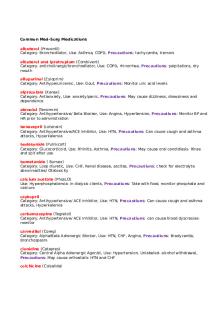
Common Med Surg Meds
- 7 Pages

Med surg dorris bowman
- 4 Pages
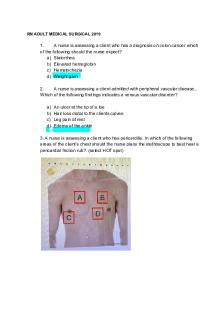
Med surg - notes
- 28 Pages
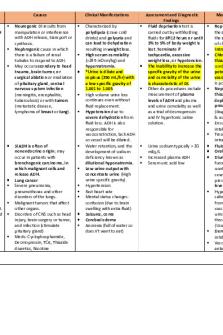
Med-Surg Endocrine
- 11 Pages
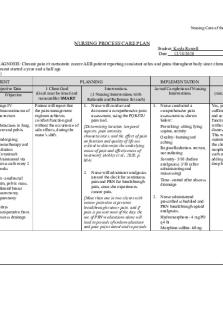
Med Surg- Care Plan
- 6 Pages
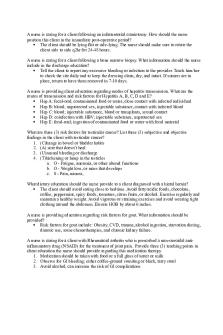
Med-Surg Capstone remediation
- 4 Pages

Med Surg Exam 3
- 19 Pages
Popular Institutions
- Tinajero National High School - Annex
- Politeknik Caltex Riau
- Yokohama City University
- SGT University
- University of Al-Qadisiyah
- Divine Word College of Vigan
- Techniek College Rotterdam
- Universidade de Santiago
- Universiti Teknologi MARA Cawangan Johor Kampus Pasir Gudang
- Poltekkes Kemenkes Yogyakarta
- Baguio City National High School
- Colegio san marcos
- preparatoria uno
- Centro de Bachillerato Tecnológico Industrial y de Servicios No. 107
- Dalian Maritime University
- Quang Trung Secondary School
- Colegio Tecnológico en Informática
- Corporación Regional de Educación Superior
- Grupo CEDVA
- Dar Al Uloom University
- Centro de Estudios Preuniversitarios de la Universidad Nacional de Ingeniería
- 上智大学
- Aakash International School, Nuna Majara
- San Felipe Neri Catholic School
- Kang Chiao International School - New Taipei City
- Misamis Occidental National High School
- Institución Educativa Escuela Normal Juan Ladrilleros
- Kolehiyo ng Pantukan
- Batanes State College
- Instituto Continental
- Sekolah Menengah Kejuruan Kesehatan Kaltara (Tarakan)
- Colegio de La Inmaculada Concepcion - Cebu


